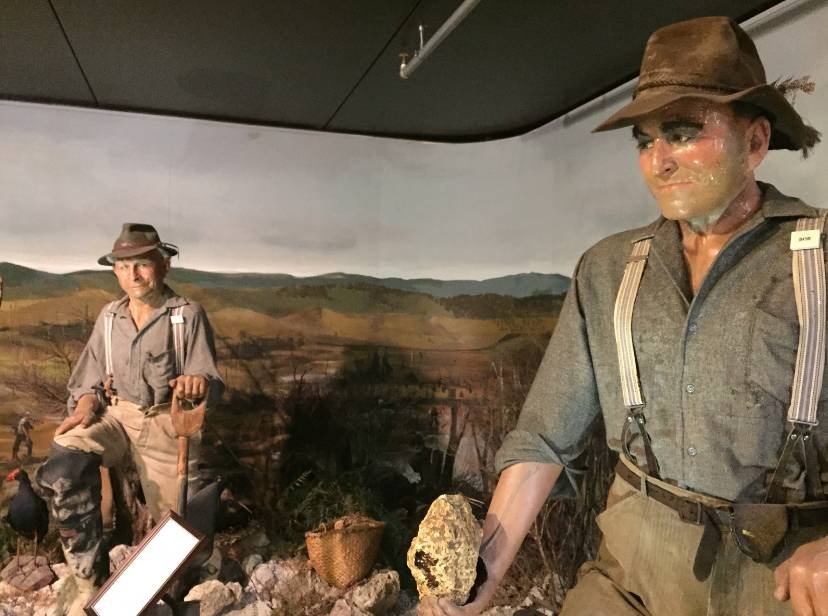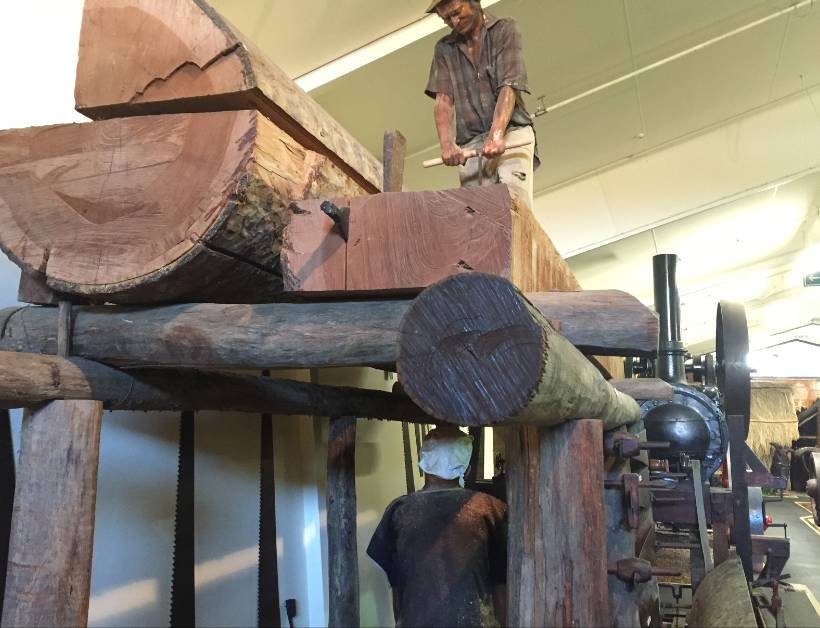Galleries

Tudor Collins Wing
The Kauri Museum journey starts in the Tudor Collins Wing where visitors will find an extensive series of early photographs providing intriguing windows into the past, most the work of Collins. Collins was heavily involved in the founding of the Museum and his photographs provide important documentation of the kauri industry and the history of Northland.
This wing includes some of the Museum’s beautiful kauri furniture collection (more available in the Volunteers’ Hall). Look to the walls of the gallery for lovely timber panels which sample New Zealand’s native trees and above for stunning examples of mottled timber.

Ross Wing
The Ross family were a renowned racing family in Northland and the gallery named for their family, houses a vast array of their racing treasures and memorabilia. From the far window, look out to where the Matakohe races were once held.
The gallery also includes more magnificent timber panels, beautifully made carvings, busts and marquetry – an important stop in The Kauri Museum’s art trail.

The Gum Room
Downstairs, the unique Kauri Museum gum room offers a display of polished and carved specimens. The Kauri Museum’s gum collection is the world’s best and biggest, an exquisite sight. The gum diggers, Steve and Bob, show what conditions were like on the gum fields. Their spears were used to find kauri gum pieces in the ground which were then dug up using spades. Pieces of rough gum contrast with the polished pieces displayed next to this scene.
A large mural by Garth Tapper, behind the gum diggers, places these figures in a typical swampy, scrubby area where the gum was found. It is easy to understand how these men worked so hard that the sweat dripped from their brows.

Sterling Wing
The Sterling Wing showcases a fascinating recreation of a quality 1880 – 1920 six room home, fully furnished with original decor and lifelike models dressed in period costume – wall to wall with authentic furniture, fittings and ornaments. The Museum’s Sterling Wing is typical of how kauri timber was used for building homes and for making beautiful furniture, full of interesting Northland heritage pieces. The Bride’s Bedroom features a bride in her lovely wedding dress. The furniture is a set using kauri and puriri burr veneer and a brass bed gleams beneath an intricate hand -worked bedcover. An ornately carved fire surround and hand painted kauri screen complete the picture.
The kitchen is typical of the early 1900 period: Kauri timber lines the walls and a wood fire is used for cooking and to heat the room. A beautiful mottled kauri sideboard and elaborate table setting also grace the room.

Smith Wing
The Smith Wing shows huge kauri logs and displays actual equipment for felling trees, transporting logs, milling timber and collecting kauri gum. The bush whim was another method of hauling logs and the example displayed was made by Bohemian settlers of Puhoi in 1912. The contraption could haul logs to a distance of one mile and was particularly useful in difficult inaccessible places where bullocks could not go.
Life in the kauri bush was tough. The men who worked on the kauri gum fields and in the bush often lived in little huts. A nikau hut display shows Trev working in one of these huts.
Enjoy the blacksmith’s workshop and the model dam. The stunning kauri bath in this wing dates back to the 1880s and has been adzed out of a solid trunk of a Kauri tree (climb in for a #kaurimuseum selfie).

Pioneers’ Wing
The Pioneers’ Wing houses a beautiful collection of household equipment, including a number of butter churns, early washing machines and floor cleaners.
The Wing also includes a weapons and armoury section.

Volunteers’ Hall
The Volunteers Hall features the world’s largest kauri slab – measuring a huge 22.5 metres long! You can also see gigantic rings showing sizes of the largest known kauri.
The Volunteers Hall boasts a striking balustrade around the stairs and mezzanine floor, amazing murals and displays of pioneering scenes, and fascinating early pioneering photographs.
Marvel at the beautiful kauri furniture including the Governor General’s boardroom table.

Sawmill Wing
The Museum includes a working sawmill at slow speed so visitors can get up close to see how the mill works. The Sawmill exhibition showcases original equipment from a real mill, originally from Hawkes Bay, and includes a range of saws for ‘breaking down’ the big logs; showing how they were converted into planks. A band saw with 42 feet on toothed ribbon steel and 7 foot diameter wheels moves slowly through a large swap kauri log. The huge band saw has 42 feet of toothed-ribbon steel moving slowly through a large swamp kauri log.
Saws are driven by slow motion hidden electric motors – the saws, flat belts, countershafts, pulleys and steam engines all move (driven by hidden electric motors) and lifelike mannequins bring this concept to life. Large sawmill machinery, including a band saw and cant frame saw planer, demonstrate changes in technology. Technology changes are shown in a fascinating display of 120 chainsaws.

Operational Machinery
When the kauri bush was felled, the landscape changed, and settlers’ farms were developed. With this era came internal combustion power. The Operational Machinery display shows the first stationary engines used to power milking machines, shearing sheds, firewood saws and other machinery driven by counter shafts.
The 1929 ‘Cat 60’ was one of the first of its kind in New Zealand and replaced the power of 112 bullocks that used to haul the massive logs – the pride and joy of this display.
The Engine Boys, a collective of engine enthusiasts, meet at The Kauri Museum every Wednesday to tend their ‘old girls’. Among the old engines are Listers, Andersons and Twiggs that date back to early 1900s.

Boarding House
A life size, two storey boarding house depicts life in pioneering times. Boarding houses provided an important point for local commerce, enabling visiting professionals such as dentists and bankers to set up shop and service the local community.
The Boarding House includes a photographic tribute to the boarding houses of the Northland region.
